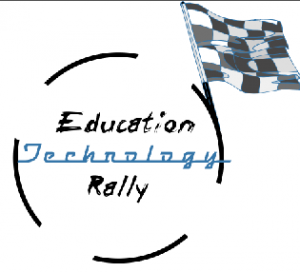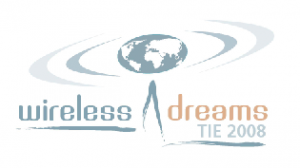In the Beginning…Computers were being introduced into schools and teachers were hungry for guidance in using them with their students. Technology leaders from Colorado traveled to California for the Computer Using Educator (CUE) conference. In 1986,a group of these educators had a “scathingly brilliant” idea (as Pat McCartney so often said). Colorado and the surrounding areas could support its very own technology conference!
In October, 1986, a creative and visionary group met to explore the possibilities. Kathy Brabec, Jan Bybee, Randy Donahoo, Rick Dutton, John Emerson, Steve King, Phil Lingwood, Carole Martinez, Kathy Nutting, Bernajean Porter, Jerry Scezney, and John Speckien devoted many hours to planning that first conference and shaping Colorado’s Technology In Education.
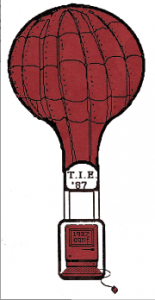 “Moving Schools Into The Information Age”, the first TIE conference, was held in Breckenridge in June of 1987. It established the model for many conferences to come. There were two days of “PreConference” where whol-e and half-day sessions explored topics in depth, followed by two days of Conference, where one- and two-hour sessions could whet the appetite for concepts to take back to our classrooms. Keynote speakers Leroy Finkle of CUE and Sue Talley from Apple inspired teachers to continue the struggle to incorporate technology. There were nearly 400 attendees; many more than the planning group had anticipated. The Colorado Department of Education and John Pierce, head of the Colorado division of the Apple Education Support Group, provided essential financial and organizational support. Apple sponsored a great tropical island party for the conference, as well as providing computers for presenters and a few hands-on labs. The familiar balloon logo that TIE continues to use was prominent on the program and throughout the Rabbit Run conference center.
“Moving Schools Into The Information Age”, the first TIE conference, was held in Breckenridge in June of 1987. It established the model for many conferences to come. There were two days of “PreConference” where whol-e and half-day sessions explored topics in depth, followed by two days of Conference, where one- and two-hour sessions could whet the appetite for concepts to take back to our classrooms. Keynote speakers Leroy Finkle of CUE and Sue Talley from Apple inspired teachers to continue the struggle to incorporate technology. There were nearly 400 attendees; many more than the planning group had anticipated. The Colorado Department of Education and John Pierce, head of the Colorado division of the Apple Education Support Group, provided essential financial and organizational support. Apple sponsored a great tropical island party for the conference, as well as providing computers for presenters and a few hands-on labs. The familiar balloon logo that TIE continues to use was prominent on the program and throughout the Rabbit Run conference center.
Attendees were offered ideas for electronic bulletin boards, desktop publishing, LOGO for programming, software from MECC, Sunburst, and Broderbund, and the concept of TI-IN for Distance Learning. From the beginning, both college credit and recertification credit was available for teachers attending the conference. The conference was a terrific success and teachers throughout the area clamored for the conference to continue.
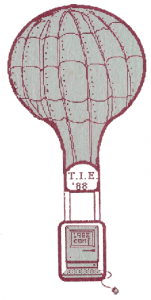 “If We Can Dream It, We Can Do It”, the 1988 TIE conference, was held in Snowmass, with Dr. David Thornburg as the keynote speaker. The original plan was to continue in Breckenridge, but the combination of a conflict with the National Educational Computing Conference (NECC) dates and the number of interested participants required a switch to a roomier facility. The first TIE Board was elected: John Speckien, Kathy Brabec, Lee Hayward, Bernajean Porter, Sandi Lamberton, and Phil Lingwood. Carole Royster of Apple secured her company’s continuing support, including computers for hands-on labs. and an Apple party for conference goers. TIE borrowed equipment from Aspen School District…the first of many districts to support TIE. The Board added a TIE bookstore, so attendees could have access to materials that they could browse before purchasing.
“If We Can Dream It, We Can Do It”, the 1988 TIE conference, was held in Snowmass, with Dr. David Thornburg as the keynote speaker. The original plan was to continue in Breckenridge, but the combination of a conflict with the National Educational Computing Conference (NECC) dates and the number of interested participants required a switch to a roomier facility. The first TIE Board was elected: John Speckien, Kathy Brabec, Lee Hayward, Bernajean Porter, Sandi Lamberton, and Phil Lingwood. Carole Royster of Apple secured her company’s continuing support, including computers for hands-on labs. and an Apple party for conference goers. TIE borrowed equipment from Aspen School District…the first of many districts to support TIE. The Board added a TIE bookstore, so attendees could have access to materials that they could browse before purchasing.
Teachers and administrators got their first look at HyperCard, the Macintosh, the XPRESS Xchange cable modem system, laserdiscs, and video digitizers at the conference. A Software Preview Lab was available, since many of us had few opportunities to see a variety of software. There were 70(!) presenters. Dick Sloan was a presenter for the first time. He has presented at every TIE conference since then. TIE became an affiliate of ICCE (International Council for Computers in Education) in the spring of 1988. And, oh, that Primavera Alfredo at Hites!!
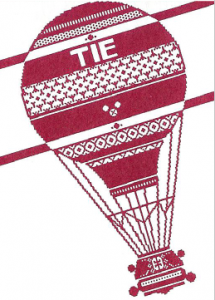 The 1989 TIE Conference in Snowmass was keynoted by Jim Mecklenburger of the National School Board and Dr. Ted S. Hasselbring of Vanderbilt University. Phil Biggs, John Roina and Ginny Jones joined the TIE Board. IBM computers made their appearance for the first time. New technologies introduced at the conference included Appleshare networking, Hyperstudio, PageMaker, LinkWay, and CARL. Long-range technology plans were the subject of several presentations; Linda Sharp (then teaching in Cherry Creek, later to be associated with Alphasmart) made the first of many presentations at TIE. The tradition of hands-on labs as a signature of the conference was finalized; more than half the rooms had labs of computers. The first of many Macintoshs was given away at the closing ceremony.
The 1989 TIE Conference in Snowmass was keynoted by Jim Mecklenburger of the National School Board and Dr. Ted S. Hasselbring of Vanderbilt University. Phil Biggs, John Roina and Ginny Jones joined the TIE Board. IBM computers made their appearance for the first time. New technologies introduced at the conference included Appleshare networking, Hyperstudio, PageMaker, LinkWay, and CARL. Long-range technology plans were the subject of several presentations; Linda Sharp (then teaching in Cherry Creek, later to be associated with Alphasmart) made the first of many presentations at TIE. The tradition of hands-on labs as a signature of the conference was finalized; more than half the rooms had labs of computers. The first of many Macintoshs was given away at the closing ceremony.
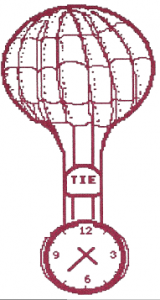 “Where In TImE is Technology”, the 1990 conference in Snowmass was keynoted by Dudley Lynch and Paul Kordis of Brain Technologies Institute and a return engagement by Leroy Finkle and Sue Talley. Randy Donahoo, Gary Armour, Donna Dayton, Dianna Lawyer-Brook, and Pat McCartney joined the TIE Board. Pat would continue to serve on the Board for nine years and chairing the conference on three separate occasions. The theme of the conference was taken from the popular Carmen Sandiego software series and was the basis for a party where attendees dressed as characters from the software…no one who was present can forget Kathy Brabec’s Carmen Miranda outfit! Apple again provided equipment and hosted a 50’s party, introducing Steve Saylor’s Karaok.
“Where In TImE is Technology”, the 1990 conference in Snowmass was keynoted by Dudley Lynch and Paul Kordis of Brain Technologies Institute and a return engagement by Leroy Finkle and Sue Talley. Randy Donahoo, Gary Armour, Donna Dayton, Dianna Lawyer-Brook, and Pat McCartney joined the TIE Board. Pat would continue to serve on the Board for nine years and chairing the conference on three separate occasions. The theme of the conference was taken from the popular Carmen Sandiego software series and was the basis for a party where attendees dressed as characters from the software…no one who was present can forget Kathy Brabec’s Carmen Miranda outfit! Apple again provided equipment and hosted a 50’s party, introducing Steve Saylor’s Karaok.
We were introduced to Microsoft Word and Works on the Macintosh, and satellite for distance learning. The low point of the conference was the loss of hot water for many in the Wildwood, forcing them to move to Silvertree. Beginning this year and continuing for seven years, Dan Petro (often partnering with Lynda Welborn) coached attendees on writing grants for technology.
 TIE Together, the 1991 TIE conference was again in Snowmass. This was the year that TIE was incorporated as a non-profit entity. The keynote speakers were Al Rogers of the FrEdMail Foundation and George Lugenbill of Apple. John Canuel, Bob VanDerWege, Candy Colborn, Elizabeth Sparkman, and Jack Knutson joined the TIE Board. Scott Weide joined the Apple team. They again provided computers and sponsored the party. Among the technologies highlighted were FrEDmail, classroom publishing, local-area networks (LANs) and CD-ROMs. Bonnie Fischer, who continues to delight teachers with ideas for the elementary classroom, was a presenter for the first time..
TIE Together, the 1991 TIE conference was again in Snowmass. This was the year that TIE was incorporated as a non-profit entity. The keynote speakers were Al Rogers of the FrEdMail Foundation and George Lugenbill of Apple. John Canuel, Bob VanDerWege, Candy Colborn, Elizabeth Sparkman, and Jack Knutson joined the TIE Board. Scott Weide joined the Apple team. They again provided computers and sponsored the party. Among the technologies highlighted were FrEDmail, classroom publishing, local-area networks (LANs) and CD-ROMs. Bonnie Fischer, who continues to delight teachers with ideas for the elementary classroom, was a presenter for the first time..
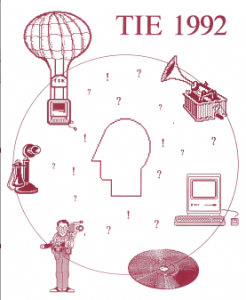 “Tools For Excellence”, the 1992 conference in Snowmass, again engaged Dr. David Thornburg to be the keynote speaker. Doris Carey and Jeanne Gieck joined the TIE Board. Jeanne allied with Kathy Brabec in planning the great TIE parties and providing hospitality to the presenters. They were individually and collectively responsible for decorations and gifts at many conferences. Roger Wagner, a name well-known to those who love Hyperstudio, was a presenter at the converence. Apple introduced Quicktime, which wowed everyone who saw it…that Chevrolet actually looked real moving across the screen.
“Tools For Excellence”, the 1992 conference in Snowmass, again engaged Dr. David Thornburg to be the keynote speaker. Doris Carey and Jeanne Gieck joined the TIE Board. Jeanne allied with Kathy Brabec in planning the great TIE parties and providing hospitality to the presenters. They were individually and collectively responsible for decorations and gifts at many conferences. Roger Wagner, a name well-known to those who love Hyperstudio, was a presenter at the converence. Apple introduced Quicktime, which wowed everyone who saw it…that Chevrolet actually looked real moving across the screen.
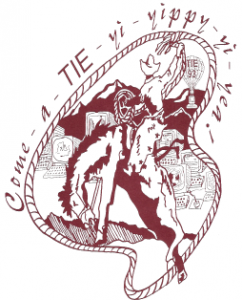 “New Frontiers in Education”, the 1993 conference, was the first held in Steamboat Springs. After finally figuring out where Mt. Chalet and the Crestwood were located at Snowmass, we were ready for a new challenge. The cowboy theme was seen everywhere. The Sheraton was a sea of cowboy hats and hay bales
“New Frontiers in Education”, the 1993 conference, was the first held in Steamboat Springs. After finally figuring out where Mt. Chalet and the Crestwood were located at Snowmass, we were ready for a new challenge. The cowboy theme was seen everywhere. The Sheraton was a sea of cowboy hats and hay bales
Dr. Eliot Soloway of the University of Michigan and Alan November were the keynote speakers and Nancy Bressler and Tom Spiers joined the TIE Board. Several sessions were presented on Apple’s Classroom of Tomorrow (ACOT); Kid Pix was the hot new software (and continues to be a staple in elementary classrooms). Grade Busters was introduced to help teachers manage their gradebooks on computers (and many felt it was a quantum leap over the MECC gradebook program). Mike Herr led teachers on the first multimedia field trip, a high point at every conference from then until now.
 “Rising to the Challenge”, the 1994 conference in Steamboat, was keynoted by Pat Wright of TCI and Dr. David Dockterman. Mike Wesley and Kay Weider joined the TIE Board. The hot new technology was the Internet (or Inter Net, as it was often called in the conference program). Teachers were learning how to use email, Gopher, ftp, and Archie. All of it was text-based and required knowing what to type on a command line. It was definitely a challenge, but a whole world of information was suddenly available. We were just beginning to hear about a graphical way of accessing the Net.
“Rising to the Challenge”, the 1994 conference in Steamboat, was keynoted by Pat Wright of TCI and Dr. David Dockterman. Mike Wesley and Kay Weider joined the TIE Board. The hot new technology was the Internet (or Inter Net, as it was often called in the conference program). Teachers were learning how to use email, Gopher, ftp, and Archie. All of it was text-based and required knowing what to type on a command line. It was definitely a challenge, but a whole world of information was suddenly available. We were just beginning to hear about a graphical way of accessing the Net.
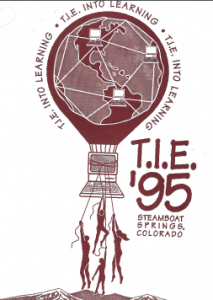 “T.I.E. Into Learning”, the 1995 conference in Steamboat, brought Apple guru, Guy Kawasaki, to be the keynote speaker at the conference. Some of you will remember that he managed to bad-mouth IBMs so much that even the Apple aficionados were uncomfortable. The Apple party was the occasion for some amazingly bad ties! Mike Herr, who continues to serve on the Board, joined the TIE Board, as did Randy Weigum, Steve Kapchinske and Brad Michels.
“T.I.E. Into Learning”, the 1995 conference in Steamboat, brought Apple guru, Guy Kawasaki, to be the keynote speaker at the conference. Some of you will remember that he managed to bad-mouth IBMs so much that even the Apple aficionados were uncomfortable. The Apple party was the occasion for some amazingly bad ties! Mike Herr, who continues to serve on the Board, joined the TIE Board, as did Randy Weigum, Steve Kapchinske and Brad Michels.
This was the year of the World Wide Web. Wow, were we blown away by what we were seeing for our classrooms. Rick Spitzer presented his ‘Giant Graphics’ for the first time. This session has been repeated at various TIE conference since and is always a winner. 1995 was also the year that the new Colorado Technology Plan was unveiled and was the subject of much discussion among the participants. The Alphasmart was making its appearance at the conference and in classrooms around the area.
 “T.I.E.-Teachers Improving Education”, the 1996 conference in Steamboat, was celebrated as the 10-year anniversary of TIE. Ruby Severson, TIE’s very own bundle of energy, joined the Board. The Board decided to try having a number of “Spotlight Speakers”, rather than one or two keynotes. Jacqui Celsi of Apple Classrooms of Tomorrow (ACOT), Rick Steenblik of Chromatek, Roger Wagner of HyperStudio fame, and (for a record third time) Dr. David Thornburg each spoke at three separate sessions. We took the gondola to the top (in the snow, thank you) and whooped it up as our favorite heroes at the last party that Apple sponsored. Randy Weigum took a unique path back down the mountain; it’s amazing what duct tape on the seat of the pants can accomplish!
“T.I.E.-Teachers Improving Education”, the 1996 conference in Steamboat, was celebrated as the 10-year anniversary of TIE. Ruby Severson, TIE’s very own bundle of energy, joined the Board. The Board decided to try having a number of “Spotlight Speakers”, rather than one or two keynotes. Jacqui Celsi of Apple Classrooms of Tomorrow (ACOT), Rick Steenblik of Chromatek, Roger Wagner of HyperStudio fame, and (for a record third time) Dr. David Thornburg each spoke at three separate sessions. We took the gondola to the top (in the snow, thank you) and whooped it up as our favorite heroes at the last party that Apple sponsored. Randy Weigum took a unique path back down the mountain; it’s amazing what duct tape on the seat of the pants can accomplish!
The new technologies were the creation of classroom web pages, the use of Powerpoint to create presentations of our lessons and for students to demonstrate their learning, and electronic portfolios as an alternative/supplement to the traditional grading system.
 “2001, a TIE Odyssey”, the 1997 conference, saw a return to Snowmass. Rick Spitzer and Mel Richardson joined the TIE Board. Thanks to the fantastic work of Randy Weigum and the equipment crew, the first conference-wide network provided access to the Internet and intranets in many labs made the loading of software via Apple Network Administrator Toolkit (ANAT) much easier than had been possible at previous conferences. The Spotlight Speakers were Don Crabb of the Chicago Tribune, Dr. Therese Crabb of Jostens Learning, Dan Kinnaman of the Technology & Learning Professional Development Institute and Joe Lambert of the San Francisco Digital Media Center.
“2001, a TIE Odyssey”, the 1997 conference, saw a return to Snowmass. Rick Spitzer and Mel Richardson joined the TIE Board. Thanks to the fantastic work of Randy Weigum and the equipment crew, the first conference-wide network provided access to the Internet and intranets in many labs made the loading of software via Apple Network Administrator Toolkit (ANAT) much easier than had been possible at previous conferences. The Spotlight Speakers were Don Crabb of the Chicago Tribune, Dr. Therese Crabb of Jostens Learning, Dan Kinnaman of the Technology & Learning Professional Development Institute and Joe Lambert of the San Francisco Digital Media Center.
Joe brought to the conference a workshop on digital storytelling that opened a new world for conference goers. Teams of parents, students and teachers worked for three days of the conference to produce their story and presented them on the last day of the conference. Instead of a sit-down dinner or buffet, the conference introduced the “Taste of Snowmass”, a unique dining experience to solve the dilemma of outgrowing the ability of any facility to hold all the attendees in one or two rooms.
In addition to Digital Storytelling, Windows 95 was a hot new technology. Netscape was the new WWW browser that everyone was using and demonstrating; rubrics were being developed as an evaluation tool and Accelerated Reading was being touted as a practical application of technology to the assessment of reading comprehension.
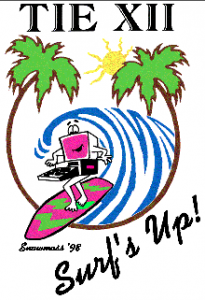 “Surf’s Up”, the 1998 conference, brought a taste of the beach to the mountains of Colorado at Snowmass. Jack Kriss and Ike Nelson joined the TIE Board. Joe Lambert returned as a Spotlight Speaker, repeating the Digital Storytelling workshop by popular demand. Annette Lamb of the University of Southern Indiana, Chris Dede of George Mason University, and Phil Raley, advocate extraordinaire of Opelika, Alabama, were the other Spotlights.
“Surf’s Up”, the 1998 conference, brought a taste of the beach to the mountains of Colorado at Snowmass. Jack Kriss and Ike Nelson joined the TIE Board. Joe Lambert returned as a Spotlight Speaker, repeating the Digital Storytelling workshop by popular demand. Annette Lamb of the University of Southern Indiana, Chris Dede of George Mason University, and Phil Raley, advocate extraordinaire of Opelika, Alabama, were the other Spotlights.
The new technology we saw was the DVD. Presenters and exhibitors were talking about the pros and cons of filtering. Linda Sharp, who had been a presenter at TIE since 1989, joined Alphasmart and brought the newest iteration of the keyboard to the conference. She continues to be one of the all-time greatest supporters of TIE. Many of us still use the beautiful leatherette cases that were the bags for our conference “stuff”. Few knew that they were a substitution for the canvas Alphasmart bags that got quarantined on the other side of the world in a freighter that couldn’t get clearance to get them to the conference on time. Those cases were an extraordinary example of “going the extra mile”!
Almost every room now was a full computer lab, networked throughout. It was made possible by 15 school districts who lent equipment to the conference.
 “Tech Trek: Mobilizing Standards”, the 1999 conference in Snowmass, was the first conference where all sessions were tied to state and national technology standards. Phil Raley was invited back, as we returned to the concept of a keynote speaker. The Cybercafe was established in the lobby of the Silvertree Hotel. With sixteen computers opened throughout the day for Internet browsing and email, attendees could stay in touch as never before.
“Tech Trek: Mobilizing Standards”, the 1999 conference in Snowmass, was the first conference where all sessions were tied to state and national technology standards. Phil Raley was invited back, as we returned to the concept of a keynote speaker. The Cybercafe was established in the lobby of the Silvertree Hotel. With sixteen computers opened throughout the day for Internet browsing and email, attendees could stay in touch as never before.
This was the year that Mike’s Camera relieved the Board of the scramble to find multimedia projectors. They outfitted every presentation room with a presentation device…and sold them to interested districts at a discount at conference end. They have generously continued to provide projectors for each conference since.
The TIE Party brought the Psychedelic Sixties to the Mall, complete with the Board in tie-dyed Tshirts. The AfterParty Party was established to allow participants to continue to party past the Snowmass Village’s deadline of 10:00 p.m. to comply with Snowmass Village’s noise ordinance. Dave and Dave kept the Cabaret hopping until the wee small hours.
The ‘hot new thing’ was Final Cut Pro and the newest technology concept introduced to attendees was the Colorado Online School Consortium, which was beginning to allow students to take classes over the Internet.
 “Stampede to Snowmass”, the 2000 conference in Snowmass (duh!), found us again wearing cowboy hats. Marsha Celesta joined the TIE Board. For the fourth time, Dr. David Thornburg was the keynote speaker. Many of the sessions were centered on the use of multimedia. The party featured attendees learning (or perfecting) their line dance skills. Boot scootin’ reached a new level!
“Stampede to Snowmass”, the 2000 conference in Snowmass (duh!), found us again wearing cowboy hats. Marsha Celesta joined the TIE Board. For the fourth time, Dr. David Thornburg was the keynote speaker. Many of the sessions were centered on the use of multimedia. The party featured attendees learning (or perfecting) their line dance skills. Boot scootin’ reached a new level!
 “Expanding Expectations”, the 2001 conference at Snowmass, was keynoted by Dr. Jane Healy, author of numerous award-winning books on the developing brain and the effects of informational technology. Randy Stall and Kay Weider (for the second time) joined the TIE Board, and Kay immediately instituted Nature Walks as part of the conference’s offerings.
“Expanding Expectations”, the 2001 conference at Snowmass, was keynoted by Dr. Jane Healy, author of numerous award-winning books on the developing brain and the effects of informational technology. Randy Stall and Kay Weider (for the second time) joined the TIE Board, and Kay immediately instituted Nature Walks as part of the conference’s offerings.
The hot new technology devices were Global Information Systems (GIS) and Global Positioning Systems (GPS). The hot new software was iMovie, which made producing a movie on CD a reality for those of us who aren’t video producers. We also participated in sessions on producing and using Webquests and learned how to adapt Six Traits Writing with technology. The Center for Teaching, Learning, and Technology opened in Denver, serving the entire state. Julie O’Brien presented at several sessions that allowed teachers and administrators to tap into this valuable resource.
 “Teaming with Technology”, the 2002 conference, was the first to be held at Copper Mountain Resort. With some trepidation, we approached a conference spread between two distinct areas. The planners at Copper had promised we would find adequate transportation between the sites. The ski busses that constantly circled from Copper Station to the Conference Center made it work! The keynote speaker was John R. Kuglin, a leading advocate and practitioner of technology in the classroom.
“Teaming with Technology”, the 2002 conference, was the first to be held at Copper Mountain Resort. With some trepidation, we approached a conference spread between two distinct areas. The planners at Copper had promised we would find adequate transportation between the sites. The ski busses that constantly circled from Copper Station to the Conference Center made it work! The keynote speaker was John R. Kuglin, a leading advocate and practitioner of technology in the classroom.
The hottest technology showcased at the conference was the use of handheld devices by both teachers and students. The live TIE website was the center of attention as several hundred donated items from exhibitors were won by lucky conference-goers.
 “Reach for the Stars”, the 2003 conference at Copper Mountain, featured the first Student Expo for Digital Media. The conference keynote was Alan November, returning after ten years to update us on his influential thinking on educational technology. Joe Buzzitta joined the TIE Board. With 205 presentations, given by 167 presenters over four days, and with a budget of a quarter of a million dollars, the conference showcased the maturing of technology in education. While we continue to look for the ‘hot’ technologies, it is this maturing of the technology and software over the years and the techniques for integrating it into the curriculum that was evident at the conference.
“Reach for the Stars”, the 2003 conference at Copper Mountain, featured the first Student Expo for Digital Media. The conference keynote was Alan November, returning after ten years to update us on his influential thinking on educational technology. Joe Buzzitta joined the TIE Board. With 205 presentations, given by 167 presenters over four days, and with a budget of a quarter of a million dollars, the conference showcased the maturing of technology in education. While we continue to look for the ‘hot’ technologies, it is this maturing of the technology and software over the years and the techniques for integrating it into the curriculum that was evident at the conference.
Despite his ‘retirement’, Steve Saylor can’t give up Karaoke at TIE and returned for the 13th year. Chuckie and the Cyclones returned to play at the AfterParty Party. The Cybercafe is firmly entrenched as an integral part of TIE. The bookstore continues to provide a valuable service and sells out of most titles, as well as selling off conference materials from previous conferences.
The story of TIE is really as much a story of people as it is of technology. It would take the entire program to mention all of them, but a few must be mentioned. Lee Hayward ran the shareware booth for many years, helped us develop Appleworks as a tool for more than we could imagine, and has taught us how to troubleshoot those pesky technology problems. Those who attended TIE during the 80s and 90s will always associate the T-shirt distribution with Jeff Koneck of Omaha. We remember his extraordinary zany costumes for the parties and his generous humor and warm smile. There are many who have continued to give quality presentations year after year. Len Scrogan, Steve Cowdrey, Spence Cutting, Mary McAuliffe, John DeTroye of Apple, Susan and Bruce Wenzlau, Anne Scott of IBM, Tracy and Richard Sutherland, Gary Murphy, Dave Robnett, Christine Archer-Davison, Denise Shorey, and Martha Wilcox are but a few of the presenters who have informed us year after year. We would be remiss not to mention the continuing support of Forest Barbieri from his days with Educational Resources to the Forest Technologies company to Quickmind. He has been a loyal friend of TIE. The contribution of the guys of ISC (and their previous incarnation as GMT) has been enormous. Without their able assistance, the dream of networking an entire conference and retain the signature of hand-on presentations as we grew would never have been possible. Hats off to all of them.
Finally, to all the previous Board members, our eternal gratitude. If you check carefully over the years, you’ll find them making presentations at the conference before they were elected to the Board…and continuing to bring their enthusiasm and expertise to the conference as presenters after retiring from the Board. Look around at your presenters this year and you’ll also see the faces of some who will join the Board of Directors and lead us on through the twenty-first century. If history is our guide, it will be a glorious ride!
Thanks to Nancy Jentzsch who served as historian for this project with the help of Ruby Severson, Kathy Brabec, Lee Hayward,

2006
